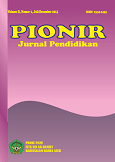PHONICS METHOD AS AN ALTERNATIVE TO FULFILL THE RIGHT TO EDUCATION OF DYSLEXIC CHILDREN IN REVIEW OF LAW NUMBER 20 OF 2003 CONCERNING THE NATIONAL EDUCATION SYSTEM
DOI:
https://doi.org/10.22373/pjp.v13i2.24503Abstract
This study is to find out how the fulfillment of the Right to Education for children with special needs who experience dyslexia through the phonics method as an alternative therapy. Many students with special needs attend public schools and they are generally dyslexic. Dyslexic children take a slower time to speak because they have difficulty remembering letters, words and sentences. This condition hampers the child's growth and development, especially in the academic process. One of the effective therapy methods in improving the reading and writing skills of dyslexic patients is phonics. This type of research is qualitative research, as a research procedure that produces descriptive data on issues related to the phonics method as an alternative therapy for dyslexic children. Judging from Law Number 20 of 2003 concerning the National Education System (UUSPN), it can be seen that the State has guaranteed legal certainty in the context of preventive protection. The research approach used is a legal and community research approach (socio legal research). The socio legal research approach is conducted to find out whether the UUSPN has accommodated the Right to Education for children with special needs who have dyslexia and whether the choice of the phonics method as an alternative therapy has become an effort to fulfill the Right to Education for dyslexic children. The phonics method can help improve the reading ability of dyslexic students, so that they can follow the learning process in class, thus the phonics method is one of the supporting factors in achieving the goals of National Education as stated in Article 3 of the UUSPN.
Keywords: Phonics Method, Educational Rights, Dyslexic Children
References
Amirudin, (2012), Introduction to Legal Research Methods, Raja Grafindo Persada, Jakarta.
Aulia Putri, (2018). Thesis: Improving Reading Skills Through the Phonic Method at Aisyiyah Bustanul Athfal Tanjung Barulak Kindergarten, Tanjung Emas District, Early Childhood Science Education Study Program, Faculty of Tarbiyah and Teacher Science, State Islamic Institute (IAIN) Batusangkar
https://repo.iainbatusangkar.ac.id/xmlui/handle/123456789/11595
Constitution of the Republic of Indonesia Year 1945 Law No. 20/2003 on the National Education System Regulation of the Minister of National Education No. 70/2009 on Inclusive Education for learners who have abnormalities and have the potential for special intelligence and/or talent
https://ciputrahospital.com/disleksia-pada-anak/
J, David Smith, (2006), Inclusion, Home School for All, Translation: Denis and Enrica, Nuansa, Bandung.
Ima Ayu Suryani, (2014). Perceptions of Regular Teachers Toward the Implementation of Inclusive Education in SMPN Se-Kota Madya Surabaya, https://ejournal.unesa.ac.id/index.php/jurnal pendidikankhusus/article/view/7561/7974
Ine Windasari et al, (2022). Case Study of Children with Reading Difficulties (Dyslexia) in Class Ii Students of Sdn Parakanmuncang I Sumedang Regency, Literature: Journal of Indonesian Language and Literature Education Volume I, No. 1, February 2022 https://ejournal.unsap.ac.id/index.php/literat/article/view/21
Najib Sulhan, (2006), Character Building in Children Teacher Learning Management Towards Effective Schools, SIC. Surabaya.
Neneng Zubaidah. (2022), Understanding Children with Special Needs, accessed at the address https://edukasi.sindonews.com/read/686647/212/memahami-anak-berkebutuhan-khusus-dan-12-klasifikasinya-1644912131?showpage=all
Rahmat Ilahi, (2021) Disabilit; is not a barrier to learning ph;sical education, Tunagrahita, Guepedia, Bogor
Ranti Novianti, (2021). The Application of the Phonics Method in Improving Beginning Reading Ability in Mild Tunagrahita Children in 5th Grade at SLB B-C Nike Ardilla Ypwn, Inclusive: Journal of Special Education Volume Vii Number 1 February 2021 http://ojs.uninus.ac.id/index.php/Inclusi/article/download/1310/863
Rifa Hidayah, (2009). Reading-Writing Ability of Dyslexic Students. Journal of Lingua, Facult; of Humanities, UIN Malang, Vol.4 No.1, p.34, https://ejournal.uin malang.ac.id/index.php/humbud/article/view/586
Surya Seftiawan Pratama, review of Dyslexia in Children, Health Article, https://ciputrahospital.com/disleksia-pada-anak/
Willy, T, Alodokter, (2019), Ministry of Health of the Republic of Indonesia, https://www.alodokter.com/disleksia
Downloads
Published
Issue
Section
License
- Authors retain copyright and grant the journal right of first publication with the work simultaneously licensed under a Creative Commons Attribution License that allows others to share the work with an acknowledgment of the work's authorship and initial publication in this journal.
- Authors are able to enter into separate, additional contractual arrangements for the non-exclusive distribution of the journal's published version of the work (e.g., post it to an institutional repository or publish it in a book), with an acknowledgment of its initial publication in this journal.
- Authors are permitted and encouraged to post their work online (e.g., in institutional repositories or on their website) prior to and during the submission process, as it can lead to productive exchanges, as well as earlier and greater citation of published work (See The Effect of Open Access).

